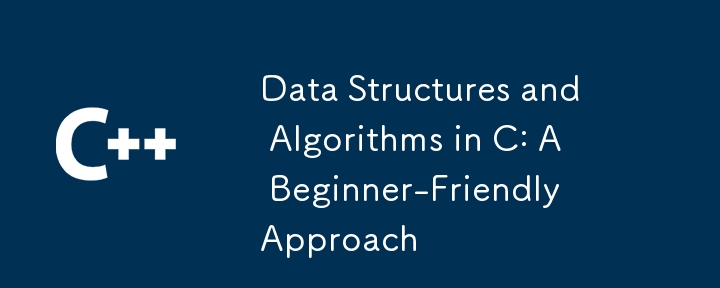Home >Backend Development >C++ >Data Structures and Algorithms in C: A Beginner-Friendly Approach
Data Structures and Algorithms in C: A Beginner-Friendly Approach
- 王林Original
- 2024-10-11 14:41:201481browse
In C language, data structures and algorithms are used to organize, store and manipulate data. Data structure: Array: ordered collection, use index to access elements Linked list: link elements through pointers, support dynamic length stack: first in last out (FILO) principle queue: first in first out (FIFO) principle tree: hierarchical organization of data algorithm: sorting: Sort elements in a specific order Search: Find elements in a collection Graph: Handle relationships between nodes and edges Practical examples: Arrays: E-commerce websites use arrays to store shopping cart item lists: Music playing

Application of data structures and algorithms in C: A friendly guide for beginners
Data structures and algorithms are the foundation of computer science and are essential for solving various problems. It's important. This article will explore data structures and algorithms in C, providing a beginner-friendly guide.
Data Structures
A data structure is a specific way of organizing and storing data, which helps in accessing and manipulating data efficiently.
- Array: an ordered collection, using a single index to access elements
- Linked list: a collection of elements linked by pointers, supporting dynamic length lists
- Stack: first-in-last A collection of FILO principles
- Queue: a collection of first-in, first-out (FIFO) principles
- Tree: a collection of data organized in a hierarchical manner
Algorithm
An algorithm is a series of step-by-step instructions for solving a specific problem.
- Sort algorithm: sort elements in a specific order, such as bubble sort and merge sort
- Search algorithm: find specific elements in a set, such as linear search and binary search
- Graph algorithm: processing relationships with nodes and edges, such as depth-first search and breadth-first search
Practical case
The following is in C Some practical examples of using data structures and algorithms:
- Arrays: An e-commerce website uses arrays to store shopping cart items.
- Linked List: A music player uses a linked list to maintain the order of songs in a playlist.
- Stack: A text editor uses a stack to implement undo operations.
- Queue: A producer-consumer system uses queues to manage queues of tasks.
- Tree: A file system uses a tree structure to organize files and directories.
Code Example
The following is a sample code in C to create a simple music playlist using a linked list:
struct Node {
char *song_name;
struct Node *next;
};
struct Node *head = NULL;
void insert_song(char *song_name) {
struct Node *new_node = malloc(sizeof(struct Node));
new_node->song_name = song_name;
new_node->next = head;
head = new_node;
}
void play_playlist() {
struct Node *current = head;
while (current != NULL) {
printf("%s\n", current->song_name);
current = current->next;
}
}Conclusion
This guide provides a friendly introduction to data structures and algorithms in C, including practical cases and code examples. By mastering these basics, you can start building powerful C programs that process and manipulate data efficiently.
The above is the detailed content of Data Structures and Algorithms in C: A Beginner-Friendly Approach. For more information, please follow other related articles on the PHP Chinese website!
Related articles
See more- C++ compilation error: A header file is referenced multiple times, how to solve it?
- C++ compilation error: wrong function parameters, how to fix it?
- C++ error: The constructor must be declared in the public area, how to deal with it?
- Process management and thread synchronization in C++
- How to deal with data splitting problems in C++ development

